
|
| Movie Title/Year and Brief Scene Description | ||||||||||||||||||||||||||
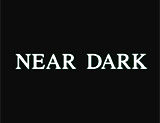
|
Near Dark (1987) #64 This revisionist vampire-western-horror film hybrid (one of the best horror films of all-time) was directed by Kathryn Bigelow - her debut film. Its tagline was:
Now a major cult film, it told about a nomadic, tightly-knit band of vampires in the American Southwest. Wise-cracking, vicious desperado-like, outlaw vampire Severen (Bill Paxton) (dressed like rock singer Jim Morrison) was a sociopathic, undead vampire. He was part of a vampire clan-family, led by Jesse Hooker (Lance Henriksen), that traveled the countryside in a blacked-out Winnebago van. Its famous setpiece was a long and drawn-out, blood-lusting roadhouse bar massacre that Severen instigated with hick customers. When the clan entered the redneck bar late one night, Severen called out:
He sat down at the bar, and taunted both a customer (Robert Winley) and the bartender (Thomas Wagner). And as a bar waitress (Jan King) served drinks to the family, she was terrorized by Jesse:
Her throat was promptly slit by Diamondback (Jenette Goldstein). Severen then insulted one of the long-haired hillbilly patrons:
He broke the redneck's neck, then complained: "I hate 'em when they ain't been shaved," before biting into the man's hairy throat. Afterwards, his famous quote, as he licked his bloody fingers, was:
Severen threatened the bartender who was struggling to reload his shotgun: "Are you havin' a little trouble with your hog-leg there?"
After striding down the length of the bar and crushing beverage glasses, he slit the bartender's throat with two swings of his boot's spurs. |
 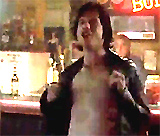 Crazed Vampire Severen (Bill Paxton) 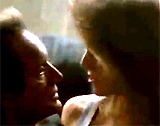 Jesse Terrorizing Bar Waitress 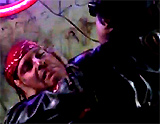 Long-Haired Patron's Neck Broken 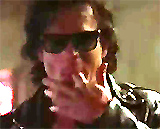 "Finger-Lickin' Good!" |
||||||||||||||||||||||||
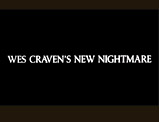
|
(Wes Craven's) New Nightmare (1994) In this horror film-within-a-film, Freddy Krueger (Robert Englund) was again assailing various Dream World victims in a series of tense scenes. Freddy's clawed fingers acted like shark fins through Heather Langenkamp's (Herself) bedsheet, and she also received stalker phone calls. Young Dylan Porter (Miko Hughes) climbed to the very top of the monkey bars under a trance. Also, the film reprised
a similar scene from A
Nightmare on Elm Street (1984), when babysitter Julie (Tracy
Middendorf) received Freddy's bladed glove in the back, then was
bloodily dragged onto the hospital ceiling where her
neck was snapped and she fell to her death. |
 Freddy's Clawed Fingers  Monkey-Bar Scene  Julie Dragged Across Hospital Ceiling |
||||||||||||||||||||||||
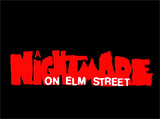
|
#17 Wes Craven's A Nightmare on Elm Street (1984) ushered in a series of films, mostly inferior to this classic first film. Most of the shocking murders in the long-running series were committed by red/green striped sweater and brown fedora-wearing dream demon Freddy Krueger (Robert Englund). Teenagers in the small town all dreamt of being pursued by a slasher-figure, with a burned face and metal clawed glove-hand. Usually, the murders (all set-pieces) by the sadistic child-murderer took place in a dreamworld setting. 15 year-old teen Tina Gray (Amanda Wyss), suffering from nightmares, was pursued into a dark back alley, where she saw the shadowy silhouette of Freddy, with a disfigured face, laughing at her. In his first startling silhouetted appearance, he unnaturally spread his arms wide to about 10 feet on both sides to scrape his right-hand fingernails -- razor-bladed -- on the alley wall, causing sparks. In Tina's mother's bedroom, boyfriend Rod Lane (Nick Corn) watched as Tina flailed about against an invisible attacker under the bedcovers. He saw her bare torso bloodily slashed open with four long gashes - obviously the bladed glove. She was picked up into the air (levitated), thrown against the wall, and dragged up to the ceiling upside-down and feet-first - with blood smearing her path, as she was slashed further and blood splattered around the room. In the middle of the ceiling, her body was suddenly released, and she flopped onto the bloodied bed and floor below, dead. Tina's friend and policeman's daughter Nancy Thompson (Heather Langenkamp) was the next one to be terrorized - she experienced a nightmarish confrontational appearance of Freddy, with a horribly burned-melted face, in her school's basement hot boiler room ("Come to Freddy"). In the film's most celebrated scene, Nancy was taking a luxurious hot bubble bath when she became drowsy and fell asleep - with her legs open. She was terrorized by the killer's clawed hand appearing and moving towards her crotch area. She was violently jerked, dragged and pulled under the water beneath the surface of the tub -- into a bottomless well or abyss below. In a panic, she flailed, gasped, choked and struggled back towards the surface, managing to break through with her hands by grasping the tub's edge. Nancy's mother Marge (Ronee Blakley) heard her screams and came to the rescue by picking the door lock, although Nancy claimed she had only slipped getting out of the tub.
Also, Freddy made a terrifying appearance in Nancy's own bedroom during another nightmare, with pillow feathers flying as he slashed at her. In the mini-dream scene, killer Freddy transformed Nancy's phone mouthpiece into his own mouth, with his long tongue darting out into the startled Nancy's mouth, as he triumphantly told her: "I'm your boyfriend, now!"- a premonition of her boyfriend's death. In the liquifying death scene, at midnight after Nancy's boyfriend Glen Lantz (Johnny Depp) had drifted off to sleep sprawled back fully-clothed on his bed with a blaring TV on his lap, Freddy's clawed hand burst through a hole in the center of the bed under him, sucked, swallowed and pulled him through the bed cover down into the hole (along with the TV, stereo, bed covers, pillow, sheet, and headphones, etc.), and then reduced him to a bloody geyser or column of his shredded and drained remains that exploded (or was vomited) out of the hole and gushed toward the ceiling, drenching the room in his blood. |
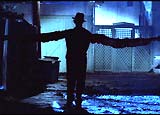 Freddy's Outstretched Arms 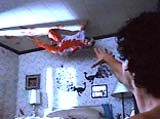 Boyfriend Rod Watching Tina's Demise During Dream 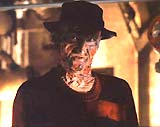 A Confrontation With Freddy Krueger in Boiler Room (To Nancy: "Come to Freddy") 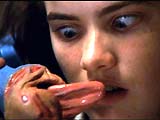 Phone Mouthpiece = Freddy's Tongue (To Nancy: "I'm your boyfriend, now!") 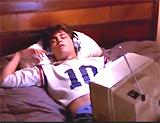 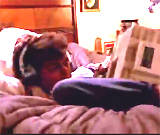 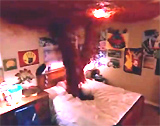 Glen Swallowed Into Bed |
||||||||||||||||||||||||
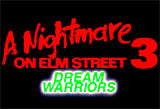
|
A Nightmare on Elm Street 3: Dream Warriors (1987) There were a number of frightening scare moments in this second sequel in the popular series: In the stomach-turning "puppet-marionette" death
scene, puppet-master Freddy Krueger (Robert Englund) manipulated
troubled teen dreamer Phillip Anderson (Bradley Gregg) like a human
marionette. Freddy used the ripped out muscle tendons from the
length of both of his hands and legs as the control chords. Also in "The Dick Cavett Show" television sequence, Dick Cavett (Himself) was interviewing guest Zsa Zsa Gabor (Herself), while disturbed and institutionalized teen Jennifer Caulfield (Penelope Sudrow) was watching and nodded off to sleep. In her nightmarish dream, the show host was abruptly transformed into Freddy. Following his inquisitive request ("Can I ask you something?"), he slashed at Gabor with the exclamation: "Who gives a f--k what you think!?"
The picture turned to static and snow, and Jennifer walked toward the screen to adjust the static-rendered picture and change the channel, hearing "One, two, Freddy's coming for you..." Suddenly, two arms (composed of wires and TV parts) ripped through the sides of the wall-mounted TV, grabbed her by the shoulders, and picked her up. Freddy's plastic-shrouded head grew and stretched out of the top of the set, with a rabbit-ear antenna mounted on top. He taunted the screaming teen: "This is it, Jennifer. your big break in TV. Welcome to Prime Time, Bitch!" He then brutally and forcefully rammed her head face-first into the TV screen, causing an explosion of glass and sparks. |
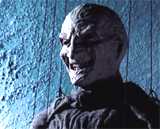 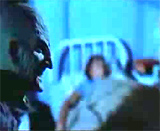 Freddy Krueger With Sleeping Victim 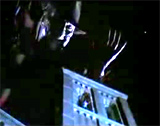 "Puppet-Marionette" Death Scene 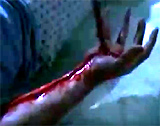 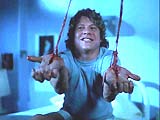 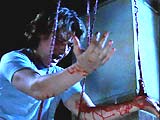 Puppet-Marionette |
||||||||||||||||||||||||
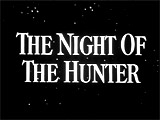
|
The Night of the Hunter (1955) #90 Director Charles Laughton's sole film was a thriller featuring a corrupt Preacher character who terrorized a lonely widow and her two children in order to acquire a hidden forture, in a series of attempts. The scariest part of the film was the main character himself - a terrifying and deranged killer-evangelist named Rev. Harry Powell (Robert Mitchum) with borderline sanity - a sinister, crazed, malevolent, black-cloaked, wide-brimmed and hatted 'Preacher.' He was a serial killer first seen driving in a stolen Model T Essex.
He delivered a chilling, perversely evil and memorable monologue to the Lord as he glanced heavenward and delivered an insane prayer, asking permission to kill another rich widow:
Then came the first sight of the Preacher's finger tattoos: LOVE and HATE emblazoned on the fingers of his right and left hands, seen as Rev. Powell attended a strip show - his left hand, tattooed with the letters "H-A-T-E" on his four fingers, clenched and then reached in his coat pocket to grab his concealed switchblade knife; as his libido was aroused, the flick-knife spontaneously opened - a sexual phallic symbol - violently and orgasmically ready to strike. He was in malevolent pursuit of a $10,000 cache of money, believed to be in the possession of the Harper family in the depressed rural town of Cresap's Landing: widowed wife Willa Harper (Shelley Winters), and her two children: young 9 year-old John Harper (Billy Chapin), and young Pearl (Sally Jane Bruce). During one frightening moment, Powell's shadow filled the window of the children's bedroom - it was the preacher dressed all in black standing by the streetlight in front of their house. He strolled away, seductively singing a modified version of his signature tune (and the film's ironic refrain), the hymn - "Leaning on the Everlasting Arms": "Leaning, leaning..."
In a tortuous wedding night scene between the Preacher and Willa Harper, she was dressed in a nightgown as she stood barefoot in front of a bathroom mirror before joining her virile husband in bed - she was vulnerable and ready to consummate her love, but he lectured her about not having any more children. Soon after, Willa was knifed to death in an A-frame bedroom - she was resigned to her death with her arms crossed over her chest; Powell delivered a benediction, and then raised his switchblade knife high above her (in his right hand - the one marked with LOVE) to carry out the ritualistic murder - on the altar-bed. Afterwards came the creepy, nightmarish, hypnotically-eerie discovery of Willa's corpse sitting underwater in a Model T with her long blonde hair tangling, swaying, and mingling diaphanously in the current with the river's underwater reeds The homicidal, Frankenstein-like Powell continued to pursue the two children in the basement fruit cellar after learning that the money was hidden in Pearl's doll. He chased them up the stairs with arms outstretched. The children escaped and fled to their father's skiff, where Powell waded out and lunged toward them with a knife, but slipped waist-deep in the mudhole as the skiff slid into the current just out of his reach. In a lyrical, fairy-tale-like nighttime sequence, the children floated down the river amidst God's benevolent creatures on the shoreline (a croaking frog, rabbits, an owl, tortoise, sheep, and a spider's web). They were continually pursued - the preacher was seen on horseback (a stolen horse) as a distant silhouette against the night-time sky as the children slept in a barn's hayloft. Powell repeatedly pursued after the children, calling out with a chilling, sing-song exclamation:
|
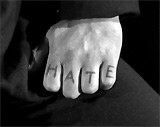 Powell's Left Hand Tattoo 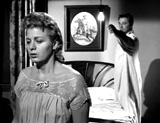 Willa's Torturous Wedding Night with The Preacher  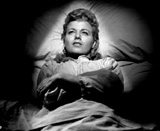 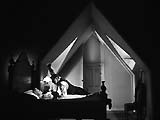 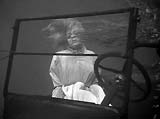 Willa's Murder in A-Frame - Viewed Sitting in Submerged Car 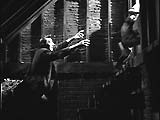 Arms Outstretched to Chase Children Up Cellar Stairs 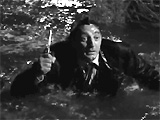 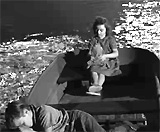 Pursuit of Children Escaping in Skiff  Shoreline Creatures - A Frog 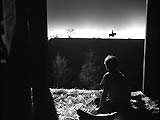 The Children's Flight From the Preacher - Seen on Horseback |
||||||||||||||||||||||||
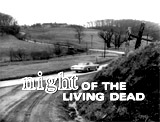
|
#9 This influential, low-budget, black and white zombie classic, an unexpected sleeper hit, was one of the first independent films to gain worldwide popularity. George Romero's redefining flick combined German expressionism with a semi-documentary style to produce a new level of gore. The major characters were under siege in a house, as they were assaulted by flesh-eating zombies. With some social commentary, sci-fi elements, and basic thriller components, this Vietnam-era film also featured a bleak, twist ending. According to news reports, a failed NASA experiment had caused dead bodies on Earth to come back to life. In the film's opening scary scene - a cemetery attack, Johnny (uncredited Russell Streiner) saw a shambling zombie (thinking it was a drunk vagrant) in a cemetery while visiting his father's gravesite. He taunted his sister Barbra (Judith O'Dea) - "They're coming to get you, Barbra!" -- when Johnny was suddenly attacked and killed by the zombie when his head was knocked against a tombstone.
Rattled female Barbra escaped to an abandoned farmhouse, where she discovered a half-eaten, partially-mutilated body of a female at the top of the stairs. There were horrific scenes of a horde of crazed, flesh-eating zombies ("an epidemic of mass murder being committed by a virtual army of unidentified assassins") surrounding the old farmhouse and terrorizing the catatonic Barbra and the resourceful Ben (black actor Duane Jones). Hands of the ghouls broke through an unguarded window.
Zombie-bitten young daughter Karen (Kyra Schon), now reanimated as a "living dead" zombie (she had been bitten on the arm), consumed her father's corpse in the cellar. Frustrated wife Helen Cooper (Marilyn Eastman) was also attacked and gruesomely stabbed to death with a garden trowel and afterwards was eaten - by her own zombified, hungry daughter Karen. Barbra was dragged away by her own zombified, 'undead' and reanimated brother Johnny and disappeared within the horde of 'flesh-eaters.' In the film's conclusion on the day after the attack, ill-fated Ben was shockingly killed with a bullet to the head by white trash, redneck, trigger-happy zombie hunters assembled in a posse. He was mistaken for one of the "living dead." Afterwards, his body was burned on a pyre of corpses.
|
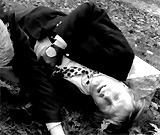 Johnny Killed as He Tried to Defend Barbra in Cemetery 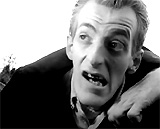 Graveyard Zombie 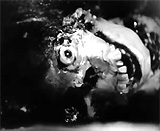 Half-Eaten Female in Farmhouse 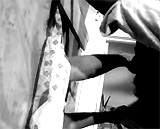 Jump-Scare: Hands Reached In Window 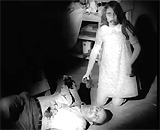 Karen Consuming Father's Corpse 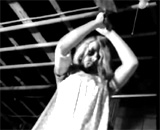 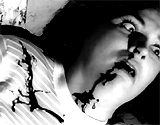 Zombie Karen's Brutal Matricide of Helen 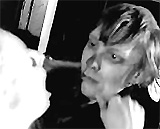 Zombified Brother Johnny's Murder of Sister Barbra |
||||||||||||||||||||||||

|
Nineteen Eighty-Four (1984, UK) A dystopian UK film from director Michael Radford - a grim adaptation of George Orwell's classic novel about Thought Police in the state of Oceania. The main character was oppressed, low-ranking, 39 year-old middle-class drone-civil servant Winston Smith (John Hurt), who worked at the Ministry of Truth (ironically-titled). His job was to alter and rewrite the past and turn 'vaporized' people into non-existent "unpersons" by erasing the person's name in old newspapers and official records. Winston experienced a nightmarish memory or recollection (in his secret journal) of a past visitation with a Whore (Shirley Stelfox) in the off-limits proletarian areas - her seemingly youthful beauty masked a middle-aged, homely, bruised and repulsive woman:
Winston soon ran into trouble after a rendezvous with the rebellious, free-spirited and sensual Julia (Suzanna Hamilton), who worked in the Ministry of Truth's Fiction Department. Julia and Winston continued their romantic liaisons and sexual relationship in a rented room above a pawn shop in the proletarian area, where they lived together and acquired contraband food ("proper white bread and jam, a real tin of milk...real coffee") and clothing sold on the black market; she surprised him by wearing lipstick and a pretty dress when she asked "Do you like me?" - and they embraced. When the couple was found out and apprehended (betrayed by Mr. Charrington (Cyril Cusack), the owner of the pawn shop and a member of the Thought Police), they were both naked. The two were separated at the Ministry, and forced to be rehabilitated and to repudiate their sexual relationship. Both were detained, questioned, and tortured by the totalitarian government. Winston experienced severe brain-washing administered systematically by suave, high-ranking Inner Party member O'Brien (Richard Burton in his last film role); he was told:
Winston was warned about Room 101 - with excruciating personalized torture as the last stage of punishment by the totalitarian government:
Winston was subjected to a cage filled with wild rats that would tear into his face, in order to break down and "cure" his insanity, have him disavow his love for Julia, and to force him to express loyalty and affection towards the Party and its leader Big Brother. In the bleak ending, Winston played chess with himself in the Chestnut Tree Cafe. He was briefly approached by an equally-changed Julia - both acted unromantically and passively to each other.
After she departed, a large tele-screen behind him played a broadcast of himself admitting his numerous crimes:
Winston turned to the image of Big Brother on the screen and whispered faintly (did he actually mouth the words or were they off-screen?) - the film's final words: "I love you." |
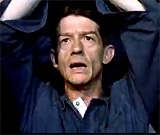 Winston Smith (John Hurt) 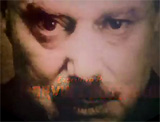 Big Brother 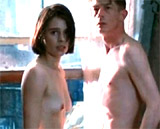  Winston Apprehended With Julia 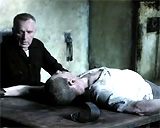 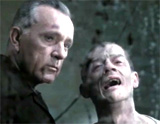 Torture by O'Brien: "You unexist...You're rotting away" 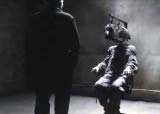 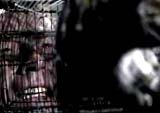  Rat-Cage Torture 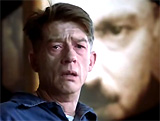 Bleak Ending: "I Love You" |
||||||||||||||||||||||||

|
No Country for Old Men (2007) #10 The dark Best Picture-winning crime drama, and western thriller from the Coen Brothers was based upon Cormac McCarthy's 2005 novel about a bad drug-deal gone wrong in early 1980s West Texas. It told of the relentless efforts of a brutal sociopathic hitman Anton Chigurh (Javier Bardem), who had escaped police custody and jail, to recover a satchel with $2 million dollars from the aftermath of the failed drug deal. The money was retrieved by Vietnam veteran and Texas resident Llewelyn Moss (Josh Brolin). The film opened with the strangulation murder of a young deputy (Zach Hopkins) in an office by the handcuffed amoral, thrill-killer Anton Chigurh (Javier Bardem), using his handcuffs as a garrote from behind. After the killing, he reacted with a grinning, satisfied exhalation, and then walked away from the bloody, scuffed-up linoleum floor from the flailing boots of the struggling man, to escape custody. In another early scene, Chigurh confronted an elderly gas station proprietor (Gene Jones) with an unexpected coin toss - for his life. Chigurh kept demanding: "Call it" - he then explained:
The man luckily called the correct toss option - 'heads' - and was spared execution. Throughout the film, the enigmatic Chigurh (one of the scariest villains ever created) killed other victims with a compressed-air cattlegun as he pursued the satchel with the money, held by Moss. When he was able to confront Moss by phone, Chigurh promised that his young and innocent wife Carla Jean wouldn't be hurt if Moss gave up the money, but he defiantly refused:
Moss' theft of the funds led to an exciting chase and cat-and-mouse pursuit game. He waited in his border town hotel room for the arrival of Chigurh to collect the money - Moss had the funds in a satchel (not knowing it had signaled his exact location with a hidden radio transponder to hired killer Chigurh). In the tense scene, Moss discovered the transponder and knew Chigurh would arrive momentarily for a showdown there. He sat readied with his shotgun after turning out the light and peering under the door. The two engaged in a vicious and bloody struggle that ended on the street and left Moss severely wounded (with a gunshot wound on his right side), and Chigurh shot in the leg. The film ended with the brutal and senseless deaths of Llewelyn Moss (by Mexicans) and his innocent wife Carla Jean (Kelly Macdonald) by psycho-killer Anton Chigurh. The evil and remorseless killer confronted Carla Jean in her bedroom - preceded by a mournful dialogue between the two. She spoke first:
Anton explained how he had earlier pledged to Llewelyn that he would kill her if he didn't bring him the $2 million in stolen drug money: "No, but I gave my word...to your husband." This was despite the fact that Llewelyn was murdered by Mexican drug lords, not Anton, and was unable to deliver the money. She responded: "That don't make sense. You gave your word to my husband to kill me?" Chigurh tried to explain: "Your husband had the opportunity to save you. Instead, he used you to try to save himself." When she told him: "Not like that. Not like you say. You don't have to do this," he responded:
Chigurh then offered her his usual 50/50 chance of survival by flipping a coin ("OK. This is the best I can do. Call it"), but she refused:
He replied: "I got here the same way the coin did." She was then predictably murdered (off-screen), signified by his leaving the house alone. |
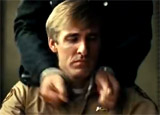 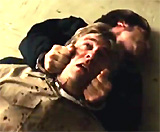  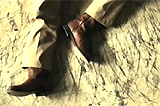 Opening Strangulation Murder of Deputy 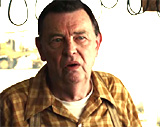 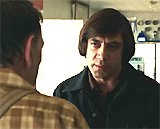 Infamous Coin-Toss Sequence: "Call it!" 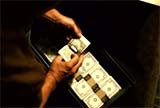 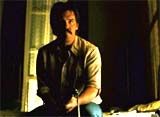 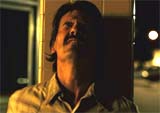 The Cat and Mouse Game for the Money 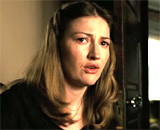 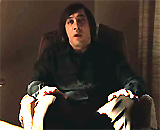 The Fateful Death of Carla Jean (Kelly Macdonald) |
||||||||||||||||||||||||

|
In Alfred Hitchcock's Technicolored thriller-spy film, advertising executive Roger O. Thornhill (Cary Grant) found himself to be the victim of mistaken identity - he was thought to be the enigmatic (and non-existent) George Kaplan. Throughout the entire film, he was abducted, interrogated, and then evaded his captors (smugglers of microfilm top-secrets), but couldn't convince anyone of his innocence. He found himself on the run as a murder suspect (for killing a diplomat at the United Nations), on a train bound for the west. In the murder sequence in United Nations building in New York, Roger was speaking to the real Lester Townsend (Philip Ober) - not the phony Townsend at the estate. After pulling a knife out of Townsend's back, Roger was photographed holding the knife in mid-air ("He's got a knife, look out!"). Roger blurted out: "Listen to me. I had nothing to do with this"- but it was assumed by the crowd that Roger had killed the UN diplomat. In a panic after dropping the knife, he rushed out of the hall, ran outside onto a long sidewalk and got into an awaiting cab (filmed from high above the UN, making him look like a tiny object being examined under a microscope).
One of the most famous and beloved set pieces ever filmed began with Thornhill's arrival by bus at a deserted Highway 41 crossroads (in neighboring Indiana) in the flat countryside where he had been lured by enemy spies on the pretext of meeting and connecting with the fabled Kaplan - his non-existent double. A stranger stood across the road from him (in widescreen) and strangely wondered about a nearby crop-dusting plane:
In a famous seven-minute pursuit-attack
sequence by the deadly crop-dusting bi-plane in the open, flat
and desolate Midwest field, Thornhill sought protection in a cornfield.
The airplane released pesticides, forcing Thornhill
out into the open. Desperate, Thornhill stepped
in front of a speeding tanker truck, which stopped just before hitting
him. The dramatic editing heightened suspense, as the strafing airplane,
having initiated another dive on Thornhill crashed into the Magnum Oil tanker. |
  The UN Murder Scene - the Real Lester Townsend Was Knifed in the Back in Front of Thornhill  Thornhill's Panic and Flight From UN (aerial view) 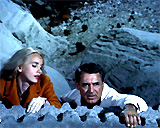 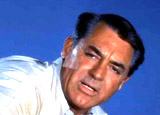 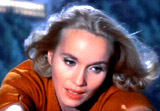 The Chase Across Mt. Rushmore, Including Cliff-Dangling |
||||||||||||||||||||||||
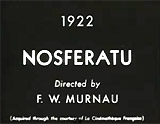 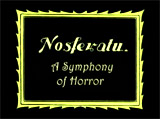 
|
Nosferatu (1922, Ger.), (aka Eine Symphonie Des Grauens or A Symphony of Terror/Horror) #47 Director F.W. Murnau's atmospheric variation on Bram Stoker's novel Dracula was the start of many iconic horror films about the non-human figure of Dracula. It introduced the character of vampirish, semi-demonic Nosferatu to cinema audiences: Count Graf Orlok (Max Schreck) was an emaciated, balding, undead vampire with a devil-rat face, pointy ears, elongated fingers on claw-like hands, sunken cheeks, and long fangs.
When Orlok entered her room, the shadow of his hand covered her heart, and he began to suck blood from her neck. She sacrificed herself to destroy Nosferatu. He was tricked by her into being preoccupied - and overstaying his welcome when a rooster crowed, signaling dawn and the beginning of daylight. He was exposed to the sun and died in front of her window, grasping his chest, and disappearing in a small wisp of smoke. |
 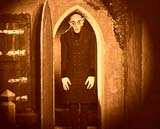 Count Orlok - In Curved Pointed Doorway 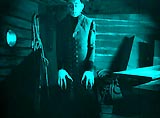 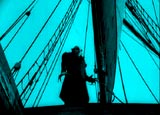 Count Orlok in Cargo Hold and On Deck On Double-Masted "Death Ship" Empusa   Count Orlok's Approach Up Stairs to Victim, Ellen Hutter |
||||||||||||||||||||||||
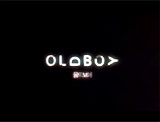
|
Oldboy (2003, S. Korea) #5 This was a mysterious and visceral (double) revenge thriller - a South Korean horror-mystery about dark secrets by director Chan-wook Park. It followed the circumstances of a womanizing businessman in the late 1980s who was kidnapped from a phone booth and imprisoned for many years in a hotel-like room - and then after being inexplicably freed and released, suffered many setbacks and punishments as he went about seeking answers and finding vengeance against his captor(s). Imprisoned and captive Oh Dae-su Oh (Choi Min-sik) was released after 15 years living in a dingy, shabby windowless cell -- without knowing the charges, although he learned by TV during his long imprisonment that he had been charged (and framed!) for the murder of his wife Kim. He didn't know about the fate of his young daughter who had just turned 4 years old on July 5th, the day of his incarceration. Recently-freed Dae-su stumbled into a sushi restaurant where he became acquainted with helpful and teenaged sushi chef Mi-do (Kang Hye-jeong). After consuming a wriggling, live octopus (eaten headfirst!) and receiving an enigmatic phone call from his unidentified captor, Dae-su fainted. Mi-do took pity on him and took him in. She assisted him in following clues in order to unravel the mystery. One of the film's excessively vulgar, devastating and scary scenes was one of extreme pain and self-torture. Dae-su confronted the prison manager Park (Dal-su Oh), and sought revenge by questioning and torturing the man who had locked him up for 15 years; during a vengeful tooth removal scene in the control room of the prison, Dae-su forcibly extracted (with the claw of a hammer) 15 of the manager's teeth; Dae-su explained: "I am going to avenge myself for all 15 years. Each tooth I extract will age you by one year." Dae-su rightfully sought revenge for his many unexplained
years of being captive, although he was given only five days
to find the enigmatic answers. He learned that his villainous, millionaire,
sadistic and insane captor-tormentor Woo-jin Lee (Yu Ji-tae),
his former high-school schoolmate, code-named Evergreen, had blamed
Dae-su for being solely responsible for spreading vicious gossip
about a possible sexual relationship with one of the other promiscuous
students. In flashback, it was revealed that young Dae-su had unintentionally
witnessed young Woo-jin participating in an overt sexual encounter
with another female student - at the time, though, he wasn't aware
that the female was Woo-jin's own sister
Lee Soo-ah (Yoon Jin-seo). The rumors grew exaggerated, including a
possible incestuous pregnancy, that allegedly
led to the humiliated sister's death (was it a suicide?). Toward the film's conclusion, Dae-su begged for Woo-jin to not inform Mi-do: ("Please, don't tell Mi-do") with evidence that he was her father. He realized that he had taken the virginity of his own long-lost daughter Mi-do (an act of unintended incest!), and that he was also at least partially responsible for the death of Woo-jin's younger sister. Dae-su admitted his sin and guilt: ("I have committed an unforgivable sin against your sister. And I also did you wrong"), but also asked for the innocent and blameless Mi-do to be spared; he began to grovel, bark like a dog on his hands and knees, and debase himself, and even subjected himself to an extremely-painful tongue self-excisement with a rusty pair of scissors - to find atonement and to prevent any further rumors or talk. In a major plot twist revelation set in an elevator, however, Woo-jin experienced a guilt-ridden memory of his sister's death - due possibly to his impregnation of her during their incestuous relationship. In a startling flashback scene, Woo-jin remembered that he had murdered his own sister (by letting go of her over the side of Habchun Dam) - she had not committed suicide. As the guilty memory from years earlier came over him, he shot himself in the side of the head inside an elevator as the door opened, leaving a bloodstain on the wall. |
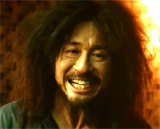 Dae-su (Choi Min-sik) Imprisoned for 15 Years  Dae-su Eating a Live-Octopus Headfirst   Prison Manager Park's 15 Tooth Extractions - One for Each Year of Incarceration  Dae-su's Tongue Self-Excisement 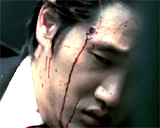 Woo-jin's Suicide in Elevator |
||||||||||||||||||||||||

|
#16 Director Richard Donner's classic supernatural horror film of possession (remade in 2006), with a script by David Seltzer, cleverly used the Biblical book of Revelation to create a mostly-believable story about Satanic conspiracy. It contained a number of cleverly-constructed set-pieces of suspense, revolving around a conspiracy that was being investigated by a well-intentioned, victimized father. It was the first part of a trilogy, followed by:
There were further films in the series after the 70s and early 80s: the TV movie Omen IV: The Awakening (1991), and the remake The Omen (2006). A local priest in Italy offered an infant child (whose mother had died) to US Ambassador to Italy Robert Thorn (Gregory Peck), after his distraught wife Katherine Thorn (Lee Remick) gave birth to a stillborn child in a Rome hospital. The child was named Damien (Harvey Stephens) - he was later thought to be the Devil's own son, or the Anti-Christ with the 666 birthmark sign on his scalp. Soon, a number of bizarrely-violent and murderous incidents occurred, involving hanging, impalement, falls, and decapitation:
|
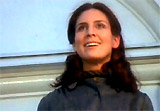 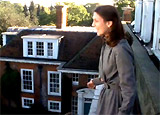 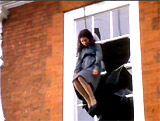 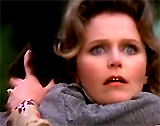 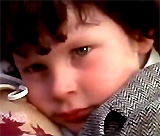 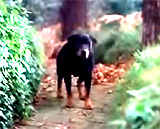 The Suicidal Death of Damien's Young Nanny 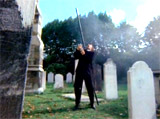 Father Brennan Skewered by a Steel Rod 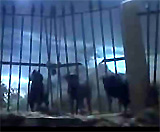 Attack by Vicious Rottweiler Dogs in Ancient Etruscan Cemetery in Italy 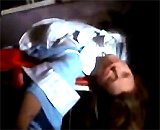 Murder of Katherine Thorn by Mrs. Baylock 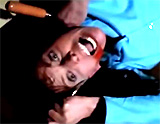 Thorn's Murder of Damien's Protective Mrs. Baylock |
||||||||||||||||||||||||

|
Open Water (2003) #9 A dramatic, nail-biting, psychological horror-thriller from independent film-maker Chris Kentis told about the fear of being left behind in open water. The low-budget film was shot with digital video to enhance its authenticity. It was based upon a true story of two divers stranded on the Great Barrier Reef in 1998. The main protagonists, a hard-working married couple, Daniel and Susan Watkins (Daniel Travis and Blanchard Ryan), were in need of a vacation. They decided upon a scuba-diving trip. The night before their excursion, the two lay naked in bed, and although Daniel was ready for sex, Susan explained that she was tired and not in the mood: "I might not be in the mood...Yeah, I'm not in the mood."
|
 Daniel and Susan Watkins (Daniel Travis and Blanchard Ryan) 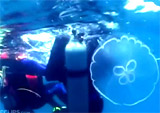 Jellyfish 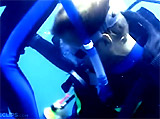 Inspecting Susan's Bite 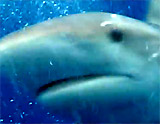 "Big Ones" 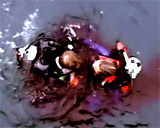 Daniel's Bloody Bite 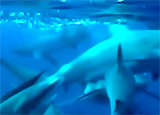 A Circling Feeding Frenzy |
||||||||||||||||||||||||
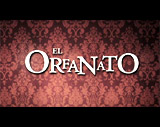
|
The Orphanage (2007, Mex./Sp.) (aka El Orfanato) This chilling gothic thriller, by first-time director Juan Antonio Bayona, centered around an abandoned Spanish seaside orphanage that was restored and set up as an institution for "special children." Red-headed wife Laura (Belen Rueda) had been raised at the institution when it was called The Good Shepherd, before it was abandoned. She had persuaded her husband Carlos Sanchez (Fernando Cayo) to reopen the orphanage, and use the facility's space to help disabled children. They moved in with their child:
Simon began to exhibit strange behavior. He had an active imagination, and would often communicate and play hide-and-seek with six imaginary "invisible friends" (or 'ghosts'). One of his imaginary "ghost" friends was named Tomas. In the game, they would hide a person's "treasure," and search for it by following clues, in order to be granted a wish. Shortly after the arrival of a strange older woman named Benigna Escobedo (Montserrat Carulla) - claiming to be a social worker - Simon learned that he had been lied to by his parents regarding his adoption. Feeling unloved, he prophetically told his mother something he claimed was told to him by Tomas. He knew that he was adopted and that he was going to soon die:
At the start of a children's welcoming party at the orphanage (during which some of the children wore masks), Simon was stubbornly disobedient, refusing to come down to participate, and Laura slapped him for his misbehavior. Later when Laura looked for him, she was confronted by a sack-masked boy in the hallway. It was presumed that the boy was Tomas (his name was sewn on his shirt). He pushed her backwards into the bathroom and locked her there when she tried to remove his mask. [Note - Spoiiler: She didn't know it at the time, but the sack-faced boy was Simon, not Tomas!] Afterwards, Simon disappeared and Laura searched frantically for him (she looked for him in a closeted door under the stairs - inadvertently rearranging some yellow steel construction posts that fell). She hysterically imagined seeing him in an ocean cave, trapped by the rising tide, but he couldn't be found. That night, Laura heard unexplainable banging noises in the orphanage. During a subsequent investigation into Simon's mysterious disappearance, police psychologist Pilar (Mabel Rivera) conjectured that Benigna might have kidnapped Simon. Six months after he went missing, Laura unsuccessfully sought support from a bereavement group, and was then dismayed when she saw elderly Benigna struck and killed by a speeding ambulance, while she was pushing a baby carriage with a mask-headed doll in it. It was revealed through Benigna's Super 8 films and photographs that Benigna had worked at the orphanage when Laura was there as a orphaned child. She had a son who was born deformed named Tomas, who was hidden away and masked ("No one knew about him"). Tomas disappeared while playing one day -- the same thing that happened to Simon. Shortly after Laura's adoption, Tomas was found dead on the beach after some of the other orphans had played a trick on him. They had taken off his sack mask in the cave - where he hid out "but he never emerged. He drowned" in the high tide. Nine months after Simon's disappearance, Laura sought out psychic medium Aurora (Geraldine Chaplin) for clues to Simon's whereabouts and evidence of anything else in the orphanage. While in a trance, she heard five, very sick children crying from the past, and when she opened a door, exclaimed: "What have they done to you?" - and then learned that the orphans had been poisoned. During a scavenger treasure hunt as Laura followed the clues, she was led to discover sacks of human ashes and partial skeletal remains in the orphanage's coal shed.
Not wanting to stay at the orphanage any longer, Laura's husband Carlos packed up and left. For the next two days, a crazed Laura, wearing an orphanage uniform, converted the orphanage to its former state, and then took sedatives to approach even closer to death - to help her find her son. She summoned the 'ghost' children (symbolized by dolls) to the dinner table by ringing a bell, and then by playing a hide-and-seek game ("One, Two, Three, Knock on The Wall") from her childhood with the apparitions that appeared. Eventually, the ghosts led her to discover Simon's corpse in the secret cellar/basement room accessible through a closet door under the stairs. She imagined that she found him alive and carried him in his arms (as the camera circled them), but he was really dead on the floor after being trapped there many months earlier (she screamed in horror: "Nooooo!"). Laura now realized that the sack-headed 'ghost' boy in the hallway during the party was her own son Simon, who had put a sack-bag on his head after she punished his misbehavior, and then hid in the secret room. When she tried to find him, she accidentally blocked the passageway to the room within the closet, and he perished there. In the end, Laura took an overdose of pills to be close to her dead son ("I want Simon back"), who came to life in her arms, as did all the other deceased children ("It's Laura"). When her husband Carlos returned, he walked up to the gravestone marker of his wife and son and the other children, to lay roses there. The film ended with Carlos finding Laura's medallion on a bedroom floor in the orphanage - he looked up and smiled as doors opened in front of him. |
 Simon's Drawing of Imaginary Playmate Tomas Wearing a Sack Mask  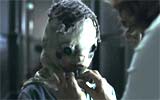 Laura Confronted by Sack-Faced Boy in Hallway (Spoiler: It Wasn't Tomas - But Laura's Son Simon!) 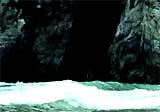 Ocean Cave Where Benigna's Son Tomas Was Drowned 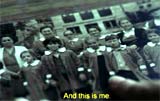 "And this is me." 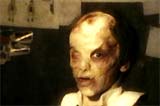 Benigna's Deformed Son Tomas 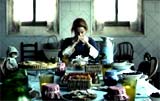 Laura's Search for Simon 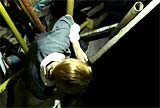 Discovery of the Closet Under Stairs 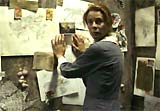 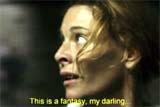 "This is a fantasy, my darling." 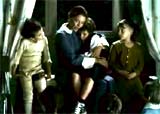 Laura's Fantasy After Her Overdose Death 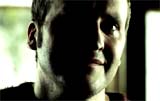 Carlos Smiling |
||||||||||||||||||||||||

|
The Others (2001) #83 Director Alejandro Amenábar's spooky, haunted house horror-thriller (his first English-language production) was set at the end of WWII, and was similar in plot to Henry James' 1898 Gothic ghost story The Turn of the Screw. It told about a family in the mid-1940s who moved into a spooky gothic English mansion - the family included:
Grace began to suspect that their rambling, remote country house was haunted when they heard odd sounds and thought there were intruders. Grace was awaiting the return of her husband Charles (Christopher Eccleston) from the war in France, a year and a half earlier. The arrival of three new servants occurred after the previous ones vanished into thin air a week earlier (without collecting their wages):
She stressed to the new hires that the curtains had to remain closed (to protect her "photosensitive" children from reacting by breaking out in sores, suffocating, and dying!), and she was concerned about doors: "No door must be opened without the previous one being closed first." She also stated: "Silence is something that we prize very highly in this house. So we have no telephone, radio or anything that makes a racket. We don't have electricity either." Another strange comment made was that the servants said that they used to work there, a few years earlier. The two young children discovered that the graves outside were of the three servants that were now newly employed (who arrived for the job even without a want ad, since Grace's letter to be mailed to the newspaper, a want-ad request, was still in the mailbox). Anne screamed for her brother Nicholas to flee: "They're dead!" The eerieness was intensified when their death (or mourning) portrait daguerreotype dated 1891 was discovered by Grace. During another scary moment, Grace confronted a decrepit old woman with a veil over her head, who had the voice of a little girl:
Grace attacked the figure and attempted to strangle it, while screaming out: "You're not my daughter" - although the figure when unveiled was her daughter! The film's title - "The Others" - referred to the Marlish family (the parents, a boy named Victor, and an older woman) who had moved into the mansion. They were considered "intruders" by Grace. The film's double-twist was revealed during a seance conducted by "The Others":
|
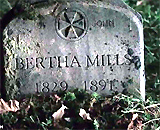 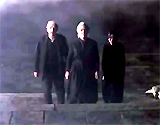 Graves of Three Servants Now Employed  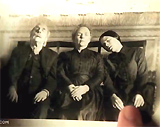 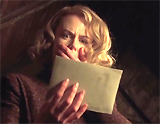 An 1891 Daguerreotype of The Three "Ghostly" Servants 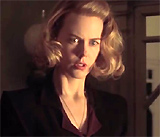 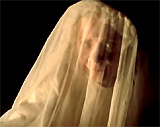 Old Woman With Veil: "I Am Your Daughter"  Woman Unveiled Was Her Daughter! |
||||||||||||||||||||||||
Intro | #s-A | B | C-1 | C-2 | D-1 | D-2 | E | F | G | H I-J | K-L | M | N-O | P | Q-R | S-1 | S-2 | S-3 | T | U-Z |